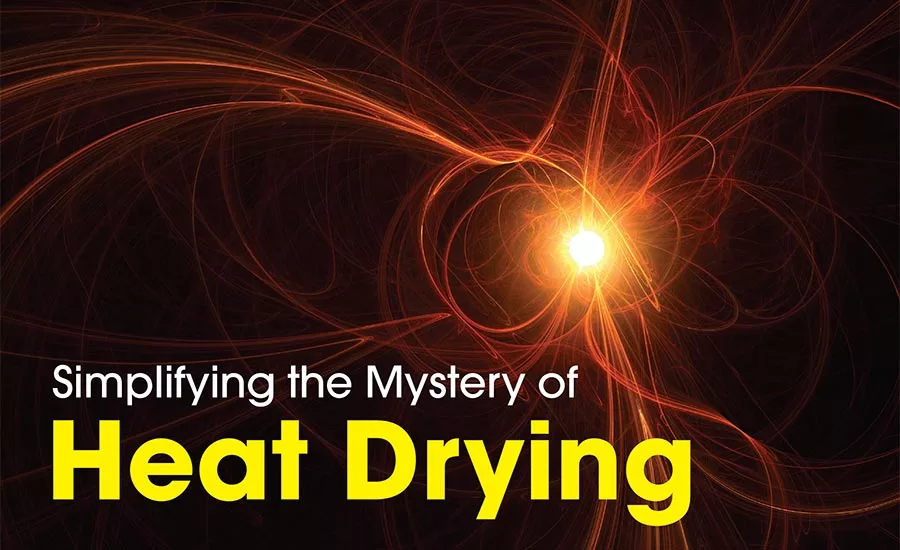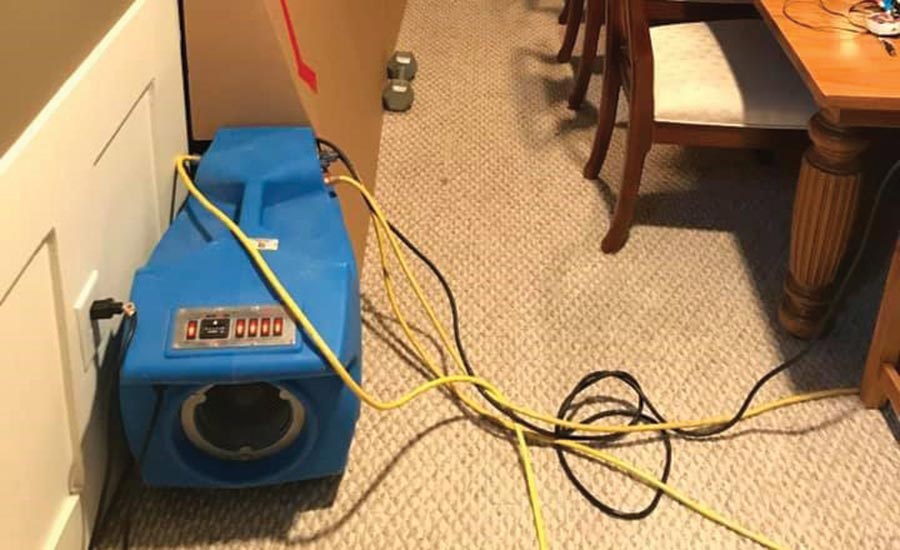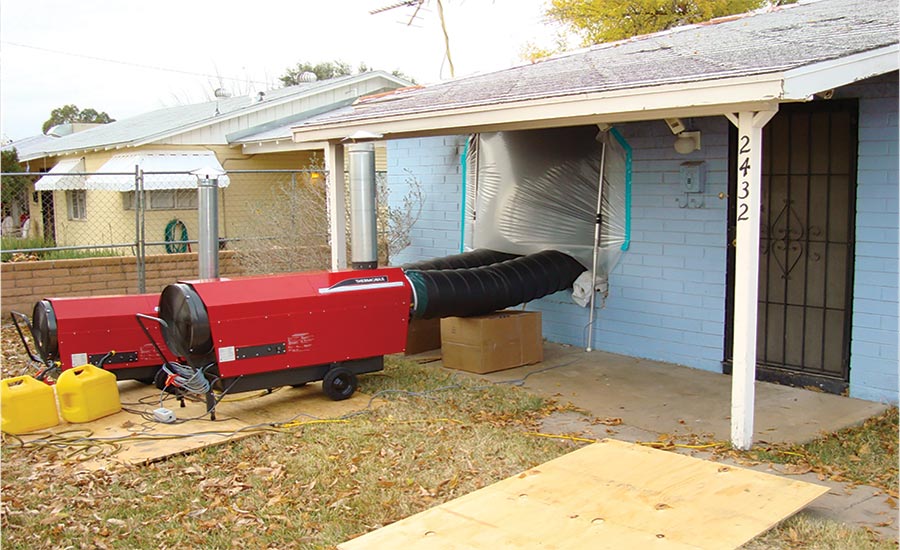Simplifying the Mystery of Heat Drying

Over the years, many people have asked me what heat drying is. The simple answer is heat drying is doing what you are already doing only using higher temperature air versus the temperature of air you are now.
We have some basic steps to accomplish when drying wet materials:
- Evaporate water from the building materials.
- Make sure that water does not return to the building materials.
To accomplish #1, we need to become experts at evaporating water from different materials.
Water evaporation is an energy-based phase change. Simply put, it takes a certain amount of energy to evaporate water. Water does not evaporate in any other way. This is regardless of what equipment or techniques you are using for drying.
The more thermal energy in the water, the faster the water evaporates. You can go look up the science on this and prove it to yourself, but do you need to? Heat water on the stove and this becomes obvious. So if adding energy/heat to the water makes the water evaporate faster, shouldn’t this be our main focus when drying? Hence what most people refer to as heat drying.
At this point, the real question becomes how do you most efficiently heat the wet materials and to what temperature? Increasing the temperature of water exponentially increases the energy for evaporation. So if you want water to evaporate faster, heat the water. Some materials release water slower. Some materials cannot handle certain elevated temperatures and various warranties or designed use of materials can be damaged by excessive, sustained temperatures. Increasing the temperature of the water does not mean you have to super heat the materials. But the difference between drying at 75°F versus 95°F is huge when it comes to evaporating water. Adding additional heat is in effect “heat drying” and becoming an expert at heating the water you are trying to evaporate is very important to being a professional in this industry.

Evaporative Cooling is Our Enemy
As a part of the evaporation process, cooling occurs. This is called evaporative cooling. When water evaporates to a gaseous state, it carries thermal energy that causes evaporation. This leaves the remaining water with less energy for continued evaporation. A lower amount of thermal energy in the water results in a slower rate of evaporation. It becomes imperative that we continue to resupply the remaining water with thermal energy to counteract the cooling effect of evaporation. Otherwise, the evaporation rate will start to decline as the evaporative cooling effect has made the remaining water cooler. This cooling effect can happen rapidly.
Techniques to Help Heat the Water
Tenting, tarping, containing, channeling, etc., are all good techniques for focusing heat onto the wet materials. These techniques reduce the airspace and therefore make it easier to heat. This does not always require a heater, as the exhaust from a dehumidifier also provides heated airflow. Concentrating the dehumidifier’s exhaust onto the wet materials instead of just allowing the exhaust heat to dilute into the ambient air is one method used to accelerate the evaporation process.
Purpose of Air Movers to Heat Wet Materials
The thermal energy needs to be transferred from the air to the wet materials. One way to accomplish this is to use air movers. Blowing air against the wet materials transfers thermal energy from the air to the materials. If we want more heat transfer, we would increase the air temperature. The air-movers will then be transferring more thermal energy to affected materials because the air has more energy available to transfer. Real simple stuff.
The more direct the airflow on the materials, the greater the transfer of thermal energy. Even now you probably notice the wall area closest to the air-mover dries quicker than the wall area farther from the air-mover. So if you want to evaporate water from materials faster you would utilize an increased amount of air movers and ensure the air is impacting the materials as much as possible.
Condensation and Dewpoint #2
As a budding drying specialist, you need to undertand the importance of removing the evaporated water from the building in a manner that does not allow for condensation, or the return of the water to the same or other materials in the building, is imperative.
Condensation can be viewed as the enemy. Condensation can occur on surfaces when there is more water vapor in the air compared to the surface temperature of building materials (dew point). Cooler building materials can cool the surrounding air and cause water vapor to condense ultimately onto those materials or surfaces. This can be a problem anytime and definitely in the winter when exterior walls, windows, etc., that are significantly colder than the dew point temperature in your drying area.
Lowering the amount of moisture in the air helps to reduce condensation. Dehumidifiers are great for this purpose and reduce the chance of condensation by removing water vapor from the air, thus creating dryer air. This can also be accomplished by ventilating the moisture-laden air out of the building. Ventilation is faster and can handle a higher capacity of evaporating moisture, but can create problems under certain conditions.

Using Heaters Without Dehumidifiers
Heaters can be used without dehumidifiers to dry a building by utilizing a technique that also dehumidifies the building at the same time. This is accomplished by drawing air from outside the building and pressurizing the building with fresh heated air. This can be done with both indirect fired heaters and electric heaters. If you are blowing 200 cfm of fresh heated air into the building, you also have 200 cfm of air leaving the building. If you have 3,000 cfm or 5,000 cfm of fresh heated air blowing into the building you have the same volume of air also leaving the building. When properly set up, you have enough air entering and leaving the building to eliminate the buildup of moisture within the building. This is because the evaporated water is being forced out of the building as quickly as it is evaporating and quick enough that the air does not have time to cool and create condensation issues.
Whether you use dehumidifiers or not in your drying, your drying is of the same principles. Evaporate the water and then remove the water from the airspace in the building. There is no magic to heat drying; there is just another technique of doing the same thing.
I want to acknowledge that my explanation is very basic and drying a structure often involves more complexity and expertise of building materials and construction. What I do want you to walk away with is the knowledge that heat drying is no different than what most are doing now. It is just the addition of more heat to a process that already uses heat to evaporate water. The bottom line is: if you want to dry faster, add heat to the water.
Looking for a reprint of this article?
From high-res PDFs to custom plaques, order your copy today!






